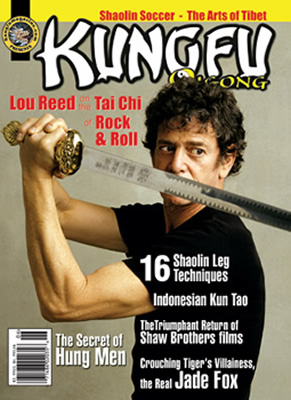 For over three decades, Laurie Anderson has been one of America’s leading avante-garde artists. In 1981, her groundbreaking track, “O Superman,” launched an artistic career that escapes definition and encompasses music, film, live performance, and installations in major museums worldwide. She was the first artist-in-residence for NASA, premiered a theatrical work at the Vancouver Olympics and was the recipient of the prestigious Dorothy and Lillian Gish prize for her outstanding contribution to the arts. She is also an avid Tai Chi practitioner.
For over three decades, Laurie Anderson has been one of America’s leading avante-garde artists. In 1981, her groundbreaking track, “O Superman,” launched an artistic career that escapes definition and encompasses music, film, live performance, and installations in major museums worldwide. She was the first artist-in-residence for NASA, premiered a theatrical work at the Vancouver Olympics and was the recipient of the prestigious Dorothy and Lillian Gish prize for her outstanding contribution to the arts. She is also an avid Tai Chi practitioner.
In 2008, she married another notable American artist, musician Lou Reed, who was featured on the cover of Kung Fu Tai Chi twice: May+June 2003 and September+October 2007. Reed was also an avid Tai Chi practitioner who studied under Master Ren Guangyi. Master Ren has also been featured on our cover several times: August 2000 and May+June 2004 and together with Reed in 2007. Master Ren has also produced numerous instructional Tai Chi DVDs through TC Media International, the parent company of Kung Fu Tai Chi, and collaborated with Reed to produce the unprecedented Tai Chi DVD, Chen Taijiquan: Lao Jia Yi Lu & Straight Sword. It was Anderson who introduced her husband to Master Ren.
A consummate storyteller, Anderson’s latest project is HEART OF A DOG. On the surface, the film is an ode to her dog, Lolabelle, a blind piano-playing and painting rat terrier. But on a deeper level, it is dreamlike beautiful meditation on death, change, pets, art, Buddhism, the post-9/11 world, surveillance technology, and so many other topics. HEART OF A DOG features stream-of-consciousness images and music, held together by Anderson’s signature ever-quizzical narration.
And it really has nothing to do with martial arts. However, as a longtime fan of Anderson’s work, I could not resist the opportunity to meet with her during the HEART OF A DOG promotion tour and discuss Tai Chi, Buddhism and art. We met in San Francisco for this quick chat.
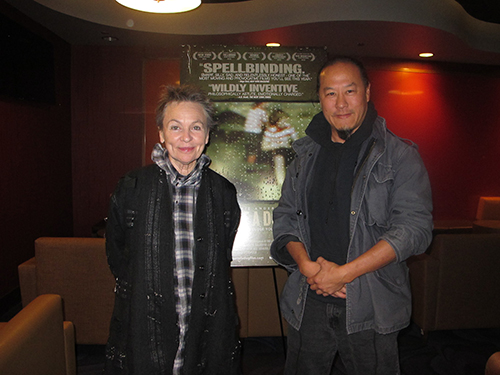
 GC: I have to begin with some questions about martial arts, given our readership.
GC: I have to begin with some questions about martial arts, given our readership.
LA: Great! Okay!
GC: Are you still practicing Tai Chi?
LA: Yeah. I go, when I’m in New York, twice a week. And I also try to do things, you know, just looking at the computer [laughs] trying to get the 38. There are a lot of things about my 38 that are terrible.
GC: How might your Tai Chi practice have affected your art?
LA: Um [pauses]. Let me think about this because it’s almost the same thing, so I have a hard time answering that in the way I would have a hard time answering, “How does meditation influence my work?” because they are kind of the same thing for me. They are really about paying attention, which is how I feel about Tai Chi as well. What’s behind you? There you are. You’re suddenly in a world that’s not about what you see in front of you but it’s where you’re placed in the middle of. So that way of being in the world has changed my life.
When I started doing Tai Chi was, let’s see, about 2000 or 1999 or something. I was looking for a teacher and Lou was doing Eagle Claw with a guy named Joe O’Conner. Do you know Joe?
GC: I’m afraid not.
LA: I hear from Joe like three times a day now. Because I’ve asked him, and some of his friends and students of Master Ren, to think about making a Tai Chi book. You know, Lou was going to write a book, but really didn’t get that far. So he didn’t leave a lot of notes or anything. He left a lot of conversations with friends. So I’m just going to try and draw those things together and make something that might have been some pale reflection of what he would have done. Joe O’Connor, let’s see what he has to say today [checks text]. He’s always comparing different martial arts to other martial arts. He’s really taking this to heart, about the book.
GC: I was stunned when you said that Lou recited Tai Chi instead of reaching for a guitar as one of his final acts.
LA: Yeah. Well it was very similar. I don’t think they were so different at all. And by that time, most of those things were being done in his head anyway. He couldn’t really do Tai Chi so well and he couldn’t play so well, so he did both of those in his head and they came out as…you know…as water.
[reads O’Connor’s text] “Palm strikes are considered to be a superior response to attacks as a palm strike can vary in intensity…” Okay, so this is today’s involving the palm in Tai Chi Push Hands strategy. He’ll just send something like this and it’s adding up to this – I think – incredible book. And the other students are commenting to me on it all the time, like someone goes, “The spiral compressed coil is a far better description of the mechanism transmitted in Tai Chi.” They are all jumping in. This is a daily thing. So this exchange might be four times a day. So I feel so connected to those ideas now because they’re coming in like that.
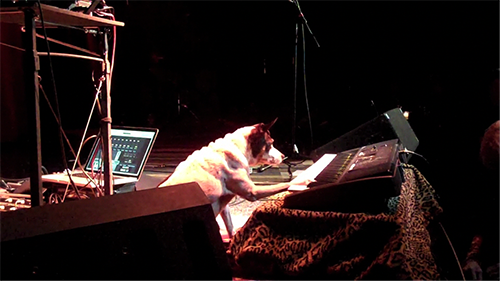
Part of it is the energy around the book, but part of it is Lou’s energy, which was very, very powerful. And for many people, me included, he is more alive and real than most people who are technically alive. I hate to say that. It’s probably not a good thing to say, but it’s really amazing energy that is available for all to use. It’s very inspiring to me because he was a person who came to play. He wasn’t goofing around. He was really about learning things and he was about finding the right teacher.
When Lou was studying Eagle Claw and I found Master Ren, I said, “Actually, my teacher is better than yours.” [laughs] He and Master Ren immediately bonded. I had to go slinking off into the bushes because, you know, I was the third wheel in that thing. So I was like, “Okay, yeah.”
So when Lou died, I went back to the class. I get up at six every Sunday to drive two hours in from the country place to do the class. And all his students are really great.
GC: HEART OF A DOG is such a meditation on death.
LA: Well, it’s also about love as well as death.
GC: Do you know the old koan, “Does a dog have Buddha nature?” I imagine you’ll say “yes” as Lolabelle was the Stevie Wonder of rat terriers.
LA: Does a dog have Buddha nature? Lou and I got another dog after Lolabelle, Little Will, who also has a cameo in the film. He’s the one that’s wearing the little clogs.
GC: That was cute.
LA: He is not a piano player, or a painter.
GC: Yet?
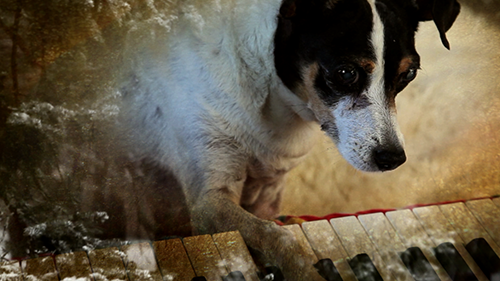
LA: No. I doubt he’s going to do that. He may surprise me. But he likes to eat. His affections are wonderful. That’s one of his skills. But most of all, it’s called HEART OF A DOG – obviously this isn’t a film about me and my dog. It is a film about everything, and so that’s why the dog ended up in the title, because they’re so good at that. I mean, they study us. And not, I think, just because we are the food supply. Although Lou and I always used to wonder what would happen if that was reversed, if they were in charge of the food, which would really be disastrous, by the way. But aside from needing us, I think they also like us, just a fellow creature liking of people. And also there’s even an admiration. Particularly, they like us because we have cars. This is a big thing for them. Speed is impressive, and wonderful. So they have this kind of ‘Yes!’ A lot of dogs love this response, this tail wagging thing that to other people might seem a bit slave-ish, but I think to dog lovers it feels like a genuine greeting.
It’s a good koan, isn’t it?
GC: Indeed. It taps at the notion of sentience.
LA: Yeah.
GC: What drew you to Buddhism?
LA: I had a friend in the seventies who said he was feeling really scattered. He had gone to Vipassana meditation, a ten-day silent meditation, and when he came back he said his mind was like a beam. I thought, “I want a mind like a beam.” This was the late seventies. I went there to this place, this Vipassana place, in Massachusetts. It’s a fairly new form of Buddhism – five hundred years old. They said, “You’re here because you’re in pain.” “No, I’m good. I want a mind like a beam.” And they said, “No, you’re a person in pain.” This is not a good way to start, this argument.
But I realized that what really shocked me was how elegantly the body codes experience so that ideas come to you, something happens and you want to scream, you put it somewhere. And it’s coded in a way that you can access it. And that was shocking to me. And eventually you can feel it going there. You can feel it routing through your body and living there. Fear going to your stomach. And jealousy. [gestures to her heart] The positive ones don’t stick around but the negative ones do. And so from like psychoanalysis, you retrieve the language. This is retrieval and processing through your body which I trust more than the storytelling part – just spin another story. And just go on and on. You wouldn’t get it.
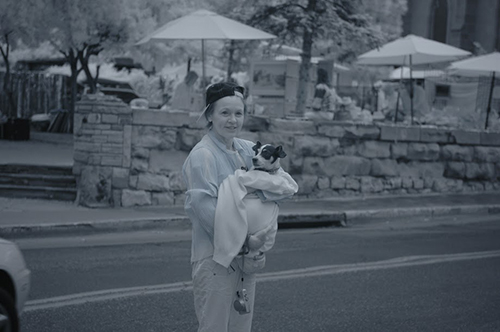
GC: It’s funny to hear you say that after your song, “Language is a virus.”
LA: [laughs] Yeah. So the body was a way for me to find that kind of suffering and try to move it. I’m not at all good at this.
I just did get a message an hour ago from Mingyur Rinpoche, who is in the middle of this film. He’s the teacher that told me, “You should try to practice how to feel sad without actually being sad.” The film is really dedicated to him as well as to Lou. And he has just emerged after four and a half years. And I got a message from somebody who is with him right now and he said, “He can call you now.” So today has been just amazing.
The two people that have been really key to what I’ve been thinking about – one had to do with this project – it’s too long to describe, maybe you read about it a little bit – called Habeus Corpus, which was a project I did with Mohammed el Gharani, who is the youngest detainee at Guantanamo. And we took him to a studio in West Africa where he sat for three days, and his image was beamed to New York in the Armory onto a statue the size of the Lincoln Memorial. So he appeared as a kind of living film. So this was a project that was simultaneous to working on the end of the film and that finally happened. It was also about stories, about his story versus the U.S. government version of the story, and identity as well. Anyway, it’s a very, very long story to tell and I know we don’t have time, but his mentor in Guantanamo was just released four days ago, called Shaker Aamer. He’s a British resident. After fifteen years of being held and tortured, he was released. So here he is, Shaker Aamer, after fifteen years, and here is Mingyur Rinpoche, who just came out of four-and-half years, and so these two people, these two poles, that I’m asking, “What is it like to be in solitude like that?” What happens to the mind when you’re in Guantanamo, which is enforced. How do you stay sane and what are the techniques for it? And the same with Rinpoche, and that’s obviously pushing another goal. So anyway, it feels like a big mind storm for these two people because they represent these two parts of what I’m trying to think about.
[Film rep gives the one-minute interview warning] Oh my gosh, this is impossible! It’s impossible.
GC: Isn’t it? Fifteen minutes. It’s like speed dating.
Time is what you never have enough of
You can't see or hold it, it's exactly like love
–“Time Turning Around,” Lou Reed
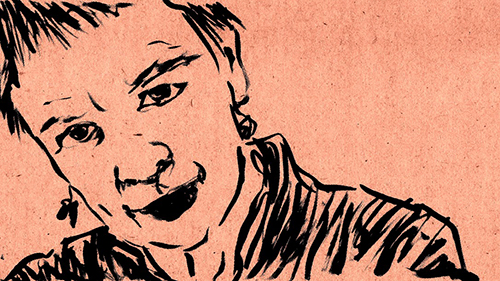
About
Gene Ching :
![]() HEART OF A DOG is showing in theaters in October 2015. For more on Laurie Anderson, visit her website at LaurieAnderson.com.
HEART OF A DOG is showing in theaters in October 2015. For more on Laurie Anderson, visit her website at LaurieAnderson.com.
![]() Print Friendly Version of This Article
Print Friendly Version of This Article
















